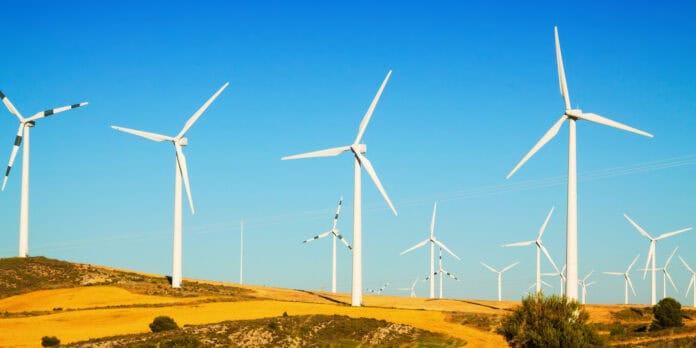Table of Contents
Here in Australia, wind turbines are an increasingly hot topic.
The Clean Energy Council says, “Wind power is currently the cheapest source of large-scale renewable energy…” and essential to combatting the climate changes that are wreaking havoc on the environment.
Nearly 50 land-based utility-scale wind turbine projects operate all over the country, and offshore wind farm construction is well underway.
Not everyone is a fan of wind power, though.
Turbines take up a lot of space, and few find them aesthetically pleasing.
Plenty of people don’t want to see turbines in the ocean or their “backyard”.
Does the amount of electricity turbines’ generate outweigh the disadvantages?
And how much power does a wind turbine produce?
Let’s find out.
(Source: Green Mechanic)
How Do Wind Turbines Work?
From sailboats to windmills, humans have been putting the kinetic energy of wind to work for thousands of years.
The mechanics behind modern wind turbines are more sophisticated, but many of the basic principles remain.
Utility-scale electricity generation installations use Horizontal Axis Wind Turbines (HAWT) — the ones you’ve no doubt seen spinning on wind farms around the country.
Essential components of a wind turbine include:
- Tower
- Blades
- Rotor
- Low-speed shaft
- Generator
The blades and rotor are mounted high on a tall, unobstructed tower to harvest the maximum amount of kinetic energy through rotation by wind.
Kinetic energy is converted to mechanical power by spinning a low-speed shaft connected to a generator.
The generator mechanism converts mechanical energy to alternating current (AC) electricity.
Learn more about how wind turbines work here.
What is the Average Power Output of a Wind Turbine?
Wind turbines come in many different sizes, and the amount of electricity a wind power system can generate varies based on numerous factors.
The following examples should give you an idea of the average power output of wind turbines in common applications worldwide.
The available wind resource and other considerations vary by location, but the basic design and scale of turbines are relatively similar for each of the applications below.
Onshore Wind Farm
The average utility-scale onshore HAWT turbine with 2.5–3 MW capacity produces over 6 million kWh of electricity per year (Wind Europe)
Offshore Wind
With an estimated 35,000km of coastline, Australia has the potential to be “a global offshore wind superpower.”
The Climate Council found that “if all the current proposed offshore wind farms were built, their combined energy capacity would be greater than all of Australia’s coal-fired power stations.”

(Source: BOEM)
As a rule, offshore wind turbines generate more electricity than an equivalent model would produce on land, largely due to the following factors.
- Higher average wind speed
- More consistent wind resource
- Better efficiency
According to the DCCEEW, “A single offshore wind turbine can provide up to 66 gigawatt hours of energy per year, enough to power 10,000 Australian households.”
Small Wind Energy Systems
There are small wind turbines marketed for residential use, but most homeowners choose solar panel systems to achieve their sustainable energy goals.
Even a small wind turbine requires a significant footprint and ideal conditions at your location in order to generate enough electricity to make the investment worthwhile.
According to a recent Clean Energy Council report:
“Rooftop solar now accounts for 11.2 per cent of Australia’s electricity supply, with households and businesses playing a leading role in Australia’s renewable energy transition.”
Thanks to Australia’s abundant sunlight, a solar generator or grid-tied balance of system is the more viable option for generating electricity than wind in almost every case.
If small wind energy is suitable for your location, it may make more sense as a supplementary electricity generation resource rather than a standalone solution.
The Clean Energy Regulator advises: “Wind turbines use wind to generate electricity. Hydro systems use water to generate electricity. Both can be used to complement solar systems.”
Unlike utility-scale turbines, the most frequently seen consumer-grade wind turbines operate on a Vertical Axis (VAWT).
One popular model can generate 10kW of AC output (maximum) under ideal laboratory conditions — which rarely exist in the real world.
Residential solar, wind, and hydro systems are eligible for various government schemes — if you meet the requirements.
Learn more about clean energy incentives.
Factors That Impact How Much Energy a Wind Turbine Can Produce
The following four factors largely determine how much electricity a wind turbine can generate at a specific location.
Average Mean Wind Speed in Australia @ 100m height/meters per second (m/s)
(Source: Creative Commons)
Wind Speed
Not surprisingly, wind speed or “wind resource” is the primary determiner of how much electricity a turbine can generate.
Wind resources are abundant in Australia, particularly in the South and Victoria.
Wind speed is highly variable and forecasts of how much electricity you can expect to generate at your location are largely based on historical data.
Learn more about how to calculate the wind potential of your property here:
Average Height, Diameter, and Rated Power of Land-Based Wind Projects

(Source: US DoE)
Size
Aside from wind speed, the size of a horizontal axis turbine’s rotor blades is the most critical factor that determines its power output.
On average, utility-scale HAWTs are getting bigger — as shown in the graph above.
For example, General Electric’s 14MW Haliade-X offshore turbine has a 220-meter rotor with 107-meter long blades and stands 260M high.
Vertical axis turbines aren’t as dependent on size for generation potential, but current designs produce less electricity and aren’t suitable for utility-scale projects.
There are innovative VAWT designs available to consumers, but they typically underperform compared to solar panel systems when it comes to return on investment.
Efficiency
Along with the conventional meaning of “efficiency” it’s also a specific measurement in renewable energy applications.
Solar panel efficiency measures the amount of electricity that is generated from available sunlight per square meter of photovoltaic cells.
The efficiency of wind turbine is measured as Capacity Factor, which we’ll explore in more detail below.
The giant GE turbine featured above has a Capacity Factor of 61%, but it won’t fit in your backyard.
Small wind energy systems typically have a Capacity Factor of around 30%.
Intermittency
The biggest challenge facing mass adoption of renewable energy systems that run on wind, solar or hydropower is intermittency.
Wind turbines don’t generate electricity on still days, solar panels don’t work at night.
For residential clean energy applications, there’s two ways of dealing with intermittency.
One is to opt for a grid-tied system that switches to utility power when electricity consumption exceeds production.
The other is to combine renewable power + storage for an off-grid or hybrid system.
For example, EcoFlow DELTA Pro is a portable power station with a solar battery that provides backup power for your entire home.
You can use it fully off-grid or integrate it with your home circuitry to stay charged and auto-switch on during a blackout.
EcoFlow DELTA Pro charges with solar panels and various other methods, including inverter generators and household AC power.
Small wind turbine systems are typically combined with solar power or connected to the utility grid, but battery storage is also an option.
How to Calculate Wind Turbine Output
Forecasting the output of any renewable energy system under real-world conditions is a significant challenge.
It’s impossible to accurately predict how much sun or wind you will receive at your location at any given hour — let alone every day.
That’s why it’s essential to understand that the rated power (typically in watts/kilowatts) of wind turbines and solar panels represents the MAXIMUM amount of electricity the unit can generate under ideal conditions.
Wind turbines and PV panels don’t produce their full rated power every hour of the day or night.
Having said that, here’s the formula for calculating wind power potential.
Power (W) = 1/2 x ρ x A x v3
Power = Watts
ρ (rho, a Greek letter) = Density of the air in kg/m3
A = Cross-sectional area of the wind in m2
v = velocity of the wind in m/s
“The power available to a wind turbine is based on the density of the air (usually about 1.2 kg/m3), the swept area of the turbine blades (picture a big circle being made by the spinning blades), and the velocity of the wind. Of these, clearly, the most variable input is wind speed. However, wind speed is also the most impactful variable because it is cubed, whereas the other inputs are not.”
The explanation comes from a helpful resource on the Penn State University website that can help you better understand how to calculate wind energy and electricity output.
Wind turbines all operate using the same basic principles, but the actual output varies by manufacturer and model.
Power Curve of the Northwind 100C, 95 kW wind turbine
(Source: Penn State Edu/Northern Power Systems)
To estimate output wattage, you must determine the system’s power curve and capacity factor.
The example above shows the power curve of a 95kW turbine at ascending wind speeds measured at the hub of the rotor blades.
Here is the corresponding AC output of the system with wind speeds measured in meters per second (m/s).
Note that the turbine only generates its rated power output of 95kW when wind speeds approach 12m/s — the equivalent of about 25 mph/40 kph.
In extreme wind conditions, output actually declines due to reduced system efficiency.
Capacity Factor is a percentage measurement of efficiency.
Capacity factor = Actual Output/Maximum Possible Output.
Put simply, how much of the total available wind power is converted into electricity?
Most small wind systems have an efficiency rating of about 30%.
(Source: National Geographic)
If you don’t have a wind meter handy, the Beaufort Scale can help you visualise wind speed at your location.
If math isn’t your thing, there are online calculators that can help you estimate potential wind turbine output based on your chosen inputs.
The Small Wind Guidebook is also an excellent resource, most of which is applicable to Australia even though it’s published by the US DoE.
Home wind energy systems may be eligible to receive Small-Scale Technology Certificates (STCs) designed to incentivise clean power generation.
Estimate how many STCs you can earn with wind, solar or hydropower here.
What are the Different Types of Wind Turbines?
There are many different “cool” wind turbine designs, but they break down into two basic categories: horizontal or vertical axis.
HAWTs
With their familiar “propeller on a tower” design Horizontal Axis Wind Turbines are by far the most common type.
Utility-scale offshore and onshore wind farms use HAWTs almost exclusively worldwide.
VAWTs
Sometimes referred to as the “future of wind power”, Vertical Axis Wind Turbines are mostly used for small wind energy applications.
Many once promising VAWT designs have failed to live up to expectations or ended up on the scrap heap.
However, VAWTs do have advantages over HAWTs for residential use, including:
- Smaller footprint
- Less “swept area” than rotor blades
- More efficient in low-wind
- Low maintenance
- Futuristic aesthetic
Frequently Asked Questions
The electricity output of wind turbines is determined by numerous factors including wind speed, system size, and efficiency. Optimal wind speed for most turbines is about 12 meters per second (m/s) — or 25mph (40km/h). A 3MW onshore turbine can generate approximately 16.5kWh daily or 6 million kWh per year.
Final Thoughts
Wind turbines are a essential component of the clean energy transition in Australia and worldwide.
Small wind energy systems may be viable in some locations, but solar generators typically generate more electricity at a lower cost.
Combining small wind and solar panel systems can also help maximise the renewable energy potential of your property.
If you’re considering clean power for your home or adventures off-grid, EcoFlow has a solution.
Check out our selection today.


